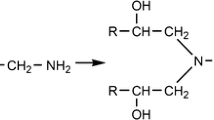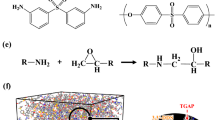Abstract
Urea-formaldehyde polymers, which are utilized in the adhesives industry, have recently been shown to be suitable materials for synthesizing micro/nanocapsules for use in self-healing (nano)composites. In this study, molecular dynamics was employed to simulate the process in which urea and formaldehyde are cross-linked via methylene and ether cross linkers, and to study the structure and mechanical/thermal properties of simulated poly(urea-formaldehyde)s (PUFs). The elastic stiffness constants of the simulated materials were calculated using the constant-strain (static) method. A temperature cycle was applied to the cross-linked PUFs, and the glass transition behavior of each material was investigated through the mean squared displacement (MSD) and temperature evolution of the energy and the specific volume of the polymer. The simulation results confirmed that there was considerable improvement in the properties of the poly(UF) materials upon cross linking. The radial distribution function was also used to study the local structures of the polymers, and this revealed that increasing the temperature and cross linking density results in a significant drop in hydrogen bonding intensity in the cross-linked PUF systems.










Similar content being viewed by others
References
White SR, Sottos N, Geubelle P, Moore J, Kessler MR, Sriram S, Brown E, Viswanathan S (2001) Autonomic healing of polymer composites. Nature 409(6822):794–797
Blaiszik B, Sottos N, White S (2008) Nanocapsules for self-healing materials. Compos Sci Technol 68(3):978–986
Cho SH, White SR, Braun PV (2008) Self–healing polymer coatings. Adv Mater 21(6):645–649
Kirkby E, Michaud V, Månson JAE, Sottos N, White S (2009) Performance of self-healing epoxy with microencapsulated healing agent and shape memory alloy wires. Polymer 50(23):5533–5538
Rule JD, Sottos NR, White SR (2007) Effect of microcapsule size on the performance of self-healing polymers. Polymer 48(12):3520–3529
Suryanarayana C, Rao KC, Kumar D (2008) Preparation and characterization of microcapsules containing linseed oil and its use in self-healing coatings. Prog Org Coat 63(1):72–78
Yuan YC, Rong MZ, Zhang MQ, Yang GC (2009) Study of factors related to performance improvement of self-healing epoxy based on dual encapsulated healant. Polymer 50(24):5771–5781
Nesterova T, Dam-Johansen K, Kiil S (2011) Synthesis of durable microcapsules for self-healing anticorrosive coatings: a comparison of selected methods. Prog Org Coat 70(4):342–352
Yin T, Rong MZ, Zhang MQ, Yang GC (2007) Self-healing epoxy composites—preparation and effect of the healant consisting of microencapsulated epoxy and latent curing agent. Compos Sci Technol 67(2):201–212
Conner AH (2001) Wood: adhesives. In: Encyclopedia of materials: science and technology. Elsevier, New York
Pizzi A, Mittal KL (2003) Handbook of adhesive technology, revised and expanded edn. CRC, Boca Raton
Accelrys Inc. (2013) Materials Studio. Accelrys Inc., San Diego. http://accelrys.com/products/materials-studio
Plimpton S (1995) Fast parallel algorithms for short-range molecular dynamics. J Comput Phys 117(1):1–19
Sandia National Laboratories (2013) LAMMPS molecular dynamics simulator. Sandia National Laboratories, Albuquerque. http://lammps.sandia.gov
Sun H, Mumby SJ, Maple JR, Hagler AT (1994) An ab initio CFF93 all-atom force field for polycarbonates. J Am Chem Soc 116(7):2978–2987
Ewald PP (1921) Die Berechnung optischer und elektrostatischer Gitterpotentiale. Ann Phys 369(3):253–287
Shokuhfar A, Arab B (2013) The effect of cross linking density on the mechanical properties and structure of the epoxy polymers: molecular dynamics simulation. J Mol Model 19(9):3719–3731
Berendsen HJC, Postma JPM, Van Gunsteren WF, DiNola A, Haak J (1984) Molecular dynamics with coupling to an external bath. J Chem Phys 81:3684
Nosé S (1984) A molecular dynamics method for simulations in the canonical ensemble. Mol Phys 52(2):255–268
Hoover WG (1985) Canonical dynamics: equilibrium phase-space distributions. Phys Rev A 31(3):1695–1697
Theodorou DN, Suter UW (1986) Atomistic modeling of mechanical properties of polymeric glasses. Macromol 19(1):139–154
Choi J, Yu S, Yang S, Cho M (2011) The glass transition and thermoelastic behavior of epoxy-based nanocomposites: a molecular dynamics study. Polymer 52(22):5197–5203
Martienssen W, Warlimont H (2005) Springer handbook of condensed matter and materials data, vol 1. Springer, Berlin
Park B-D, Frihart CR, Yu Y, Singh AP (2013) Hardness evaluation of cured urea-formaldehyde resins with different formaldehyde/urea mole ratios using nanoindentation method. Eur Polym J 49:3089–3094. doi:10.1016/j.eurpolymj.2013.06.013
Yang S, Qu J (2012) Computing thermomechanical properties of crosslinked epoxy by molecular dynamic simulations. Polymer 53(21):4806–4817
Wu C, Xu W (2007) Atomistic molecular simulations of structure and dynamics of crosslinked epoxy resin. Polymer 48(19):5802–5812
Acknowledgments
The authors would like to thank Prof. Antonio Pizzi (University of Lorraine, France) for helpful discussions. The High Performance Computing (HPC) Laboratory, Institute for Research in Fundamental Sciences (IPM), Tehran, Iran is also acknowledged for providing computational facilities for our simulations.
Author information
Authors and Affiliations
Corresponding author
Rights and permissions
About this article
Cite this article
Arab, B., Shokuhfar, A. Molecular dynamics simulation of cross-linked urea-formaldehyde polymers for self-healing nanocomposites: prediction of mechanical properties and glass transition temperature. J Mol Model 19, 5053–5062 (2013). https://doi.org/10.1007/s00894-013-1996-4
Received:
Accepted:
Published:
Issue Date:
DOI: https://doi.org/10.1007/s00894-013-1996-4




